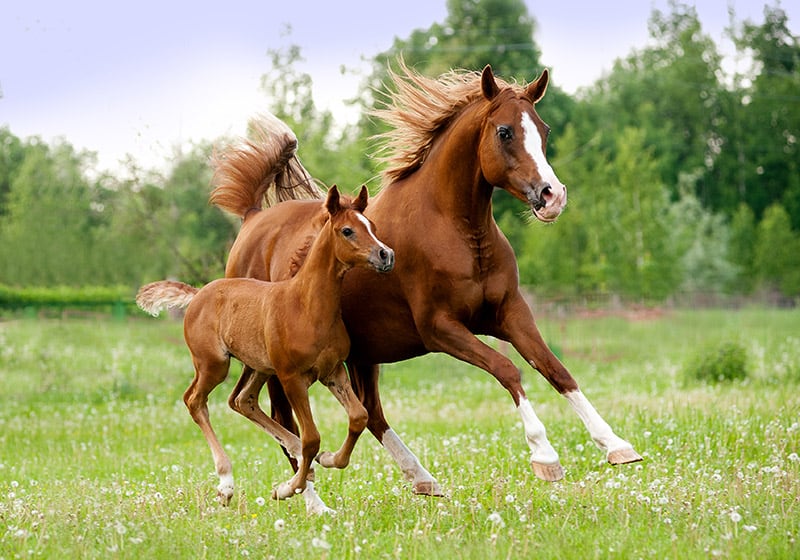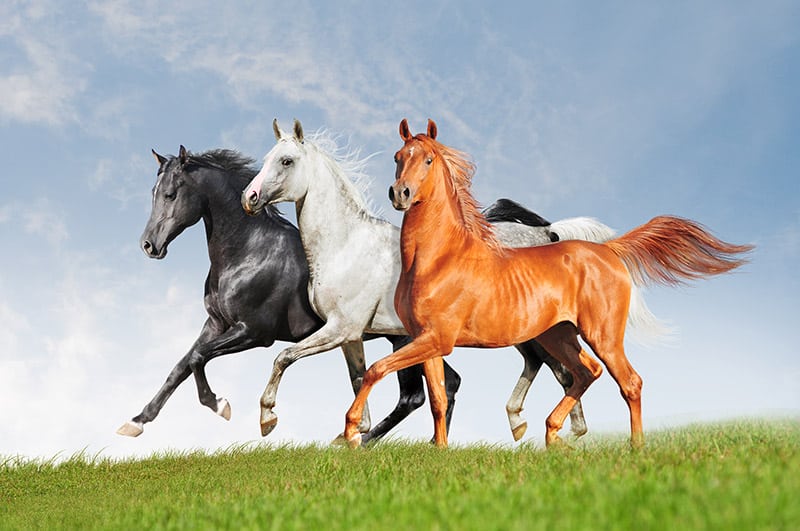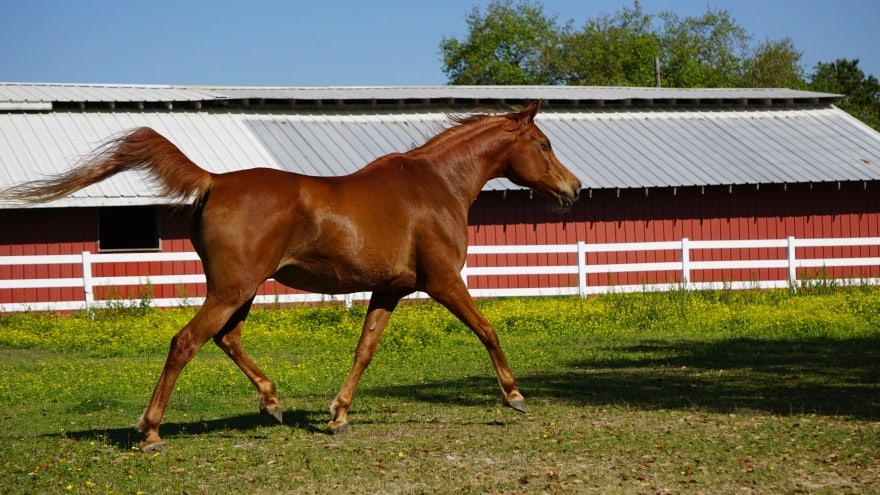The Arabian, known for its incredible endurance, can maintain a run for over 100 miles!
The Arabian, one of the oldest breed of horse, and is also the purest breed of horse. They have existed for at least 4,500 years. The Arabian horse is known to have been in existence since the time of Muhammad. It is also believed to have been developed by the nomadic Bedouin’s in the desert belt of Africa, extending from the Atlantic Ocean to the Arabian Desert, for 2,500 years prior to that. As Islamic influence spread so did the Arabian horse, to be bred all over the Middle East and North Africa. With the Moorish invasion of Spain in the 7th century it was introduced to Europe.
The Arabian horses have a beautiful and unique appearance. They are generally small in stature but readily recognized by their dished face and fine features. As they were bred in different parts of the world various breeds emerged including the Polish Arabian, the Shagya Arabian in Hungary, and the Egyptian Arabian. The Arabian blood contributed to the development of many other fine breeds as well, such as the Lipizzaner and the Thoroughbred, and it is still used to improve and refine other breeds.
In early times they were renowned for their incredible endurance and courage. Today Arabians are known for their “people-oriented” nature and loving disposition, which makes them great pleasure horses and pets. They are also known to be very intelligent. They are quick to learn and willing to please.
Scientific Classification
| Kingdom: | Animalia |
| Phylum: | Chordata |
| Class: | Mammalia |
| Order: | Perissodactyla |
| Family: | Equidae |
| Genus: | Equus |
| Species: | caballus |
Horse Breeds
The Andalusian or Spanish Horse is a light horse breed. The light horses are also referred to as a warmblood or ‘hot-blooded’ horse. Light horse breeds generally weigh under 1,500 pounds. They are typically used as riding horses for leisure and trail riding. Being agile and swift, many are also used on the racetrack, in the show ring, and for work on the ranch.
Light horses are grouped in a couple of different ways, one being the continent or country where they originated from. They are also grouped according to training, classified as either a stock type, hunter type, saddle type, or ‘other’. A body type is generally attributed to each class, with the ‘other’ classification being a bit of an odd ball. It includes those that are color breeds or those that may fit a body type of one of the training classes, but not be used for that type of training. The ‘other’ types can also include those that may fit into more than one of the type groups.
The horse class the American Mustang fits into is the ‘other’ type class.

Horse Backgrounds
It is known that the Arabian has been in existence since the time of Muhammad. But it may have been bred by the Bedouin of Arabia for 2,500 years prior to that although there are no written records, making it one of the oldest breed of horse still being bred today. The historian El Kelbi wrote the first history and pedigree of the Arabian horse in 786 AD.
The spread of Islam contributed to the spread of the Arabian horse. As Islam spread to Turkey, Persia, Palestine, Syria, and North Africa, the Arabian horse began to be bred all over the Middle East and North Africa. It was introduced to Europe when the Moors invaded Spain in the 7th century, and became desired for its beauty, endurance, and courage. Emperor Napoleon rode a grey Arabian named Marengo into the battle of Waterloo.
As Arabians were bred in different parts of the world, subsequent breeds of Arabians have developed such as the Polish Arabian, the Shagya Arabian in Hungary, and the Egyptian Arabian. Arabian blood has contributed to many other breeds such as the Lipizzaner and the Thoroughbred, and because of its purity, continues to act as an “improver” to refine other breeds.
Description
The Arabian has a very unique appearance. It is generally small in stature with an average height of 57 inches or 14.3 hands. Although many fall within the height range of a pony, they are always considered horses.
The most distinctive features are the outline and the shape of the head. The unique outline is created by a skeletal formation that differs from other horses. The Arabian has 17 ribs, 5 lumbar bones, and 16 tail vertebrae where other breeds generally have 18 ribs, 6 lumbar bones, and 18 tail vertebrae. This difference accounts for the shape of the Arab’s back and the high carriage of the tail.
Arabians are generally fine boned and have a small, refined head. The famous dished face is created by the indentation that begins below the eyes and down to the muzzle. They also tend to have an arch at the point where the head meets the neck, and the greater the arch, the greater the range of motion of the head. Arabians can be grey, chestnut, bay, and black (see color descriptions).
Arabian lines that were bred separately from the purebred Arabian have created distinctive breeds, namely the Polish Arabian, Egyptian Arabian, and Shagya Arabian. These breeds tend to be larger than the pure Arabian and have thicker bones.
Horse Care and Feeding
Arabians tend to do better if they are kept in larger paddocks and not confined to small stalls because their intelligence causes them to be easily bored. They may be more prone to developing nervous habits or “stable vices” when confined than other horses. Keeping them in a paddock with other horses is ideal. You can also try to keep them occupied with objects they can play with, such as horse balls and traffic cones.

Horse Training and Activities
Arabians mature more slowly than other horse breeds, and are not fully mature until five years of age. This means that owners of young Arabians must be extra careful not to strain their horse’s legs, tendons, and joints before they have fully developed. Intense riding and jumping are definitely not a good idea until an Arabian is five years old.
Arabians are great pleasure horses as they are generally willing to please, but they can be very energetic and spirited as well, so they may not be the best horses for children and beginners. They do very well in the show ring in pleasure, dressage, and trail classes due to their gracefulness and agility. They are also great reining horses. They can be used for jumping although they are not top competitors.
The discipline they excel in is endurance riding because they have the energy and the willing personality to travel over great distances with a rider. Endurance rides can be single or multi-day events where horses race along a trail through all kinds of terrain for 30 to 100 miles a day!
Common Health Problems
Arabians are known for being a sound breed due to their strong legs and dense bones, and they tend to have a low occurrence of lameness problems.
Availability
Arabians are popular in many parts of the world and should be readily available throughout the United States, Europe, the Middle East, and Asia. Like all horses, they range in price, but generally speaking they are not relatively expensive. Look in local ads or pick up regional horse magazines at your local tack and feed store to find horses for sale in your area. .
Featured Image Credit: Trevor G Johnson, Shutterstock
